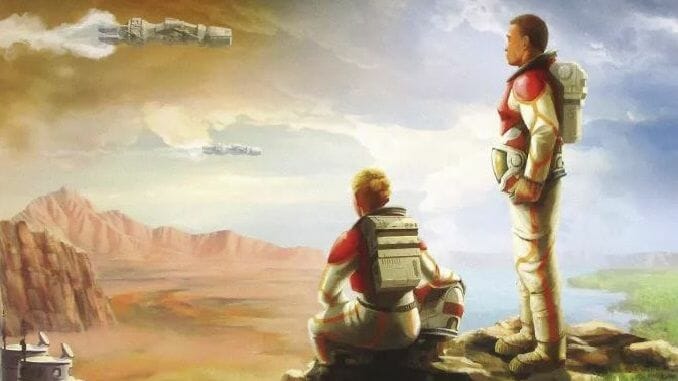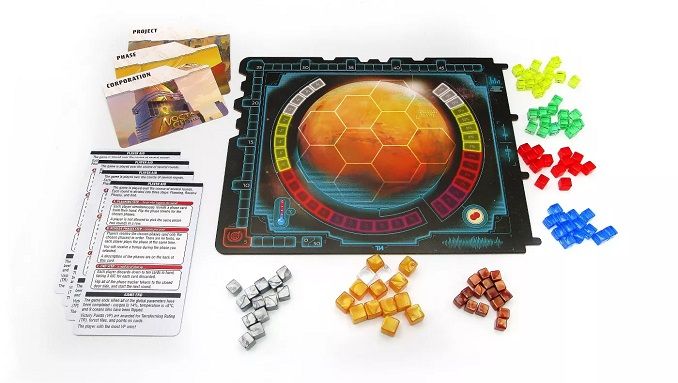Terraforming Mars: Ares Expedition Improves on a Modern Board Game Classic
Games Reviews board games
Terraforming Mars is one of the most acclaimed and top-rated board games ever, sitting at #4 on the Boardgamegeek all-time ranking, which skew towards very heavy games, behind an RPG-in-a-box (Gloomhaven), a legacy game (Pandemic Legacy: Season 1), and another heavy economic game (Brass: Birmingham). One thing these all have in common is long play times—two hours for a session is not uncommon, and the first two titles are designed for multiple, sequential plays. That’s fine, but it’s niche boardgaming—it is a tiny circle within the larger circle of “people who like board games,” or even the medium-sized circle of “people who like board games other than Monopoly and Scrabble.”
That made Terraforming Mars a perfect starting point for a simpler version—not just a brand extension, as we see with many card or dice adaptations of strategy games, but just a streamlined adaptation of the original game, one that plays a little more quickly, has fewer rules and parts, and reduces the high cognitive load of the original. Terraforming Mars: Ares Expedition does exactly that—it is Terraforming Mars in a smaller package. It loses little if nothing from the first game other than weight, and if I’m being realistic, I’d probably never choose to play the bigger game if this one is around.
Ares Expedition trims a lot of the fat—fans of the original game might cringe at that, but there’s some complexity for complexity’s sake in it—from Terraforming Mars, with a smaller board of the planet itself and smaller, easier-to-read player boards and cards. The main goal of the game is the same: get the most points you can while all players simultaneously work to terraforming the red planet by increasing its temperature and oxygen levels and increasing the water on the surface. You do so by playing cards to your own tableau, gathering resources, and taking actions. Once all three of those environment trackers reach their maximum levels, the game ends, and players add up the points on the cards they’ve played, points they collected through actions, and their position on the point track around the main board.

In Ares Expedition, each player has five Phase cards that represent different things you can do on a turn—Development and Construction let you build certain cards from your hand, Action lets you take any special actions from cards you’ve played plus standard actions to raise the environmental variables, Production is just what it sounds like, and Research lets you draw more cards. Your personal board tracks your production levels of four resources—money, heat, plants, and new cards—as well as two types of building discounts, steel and titanium. You can gather money, heat, and plants and store them on your board for future use, while steel and titanium are applied when you build. Money does make the red world go around, as you need it to build cards, and you can use it to boost any of the environmental variables. You can use heat tokens to raise the temperature, and plant tokens to increase the oxygen level. Many buildings will let you use those resources for other purposes, or give you discounts when you do use them (e.g., dropping the cost to flip an ocean tile from 15 money to 10). Also, when you increase any of the environmental variables, you get a victory point, and the income you get in the production phase is based in part on your victory point total at that time.
As in the original game, the pace accelerates as you go, because players get more resources every production phase, and thus can boost those variables faster. You can spend resources to increase an environmental variable, which gets you a victory point and increases your income by 1, and then you can use the income to build faster or increase those variables again. You’ll build more cards early in the game, and go for resources and points later in the game, but the last 15 minutes really fly by. It’s a more compact and thus, for me, more satisfying engine-building experience, because you can see the end goal sooner, and the game asks you to keep a little less in your head as you go. Play time is listed at an hour, and that’s doable with one to three players, although I’m guessing with four it might go a little longer. You can take Phase actions simultaneously, which speeds things along.
Terraforming Mars: Ares Expedition also has a strong solo mode that eschews victory points: You just have to max out the three environment trackers before you go through five complete rounds, or 25 turns. You take a set of five phase cards for a dummy player and draw one randomly on each turn. You take a Phase of your own choosing, then use the dummy’s phase, unless you both chose the same one (then you just do it once). You do this four times, for 20 turns, and in the fifth round, you choose the order for the dummy’s five phase choices. Points are irrelevant—you’re just going for broke to terraform the planet. The novice and advanced modes give boosts to the trackers after each round, while expert mode leaves it all to you. On my first solo play (after playing the regular game), I tried the expert mode and maxed out the temperature tracker and flipped all the ocean tiles, but fell two spaces short on the oxygen tracker. I just never got enough plant production, and didn’t get a card that would give me another way to increase oxygen production at some sort of discount. It’s a fun and well-balanced challenge.
The Phase idea will remind players of Race for the Galaxy, but I have always found that earlier game to be pretty unbalanced, both in terms of the strengths of the phases and of the value of specific strategies (produce/consume x2 is very tough to beat). The five phases here have different utilities at different points in the game, but they’re all useful. One rule says you can’t pick the same phase twice in a row—you pick up the phase you just used after you play the next one—so you can also plan your phase choices around what your opponents picked (or what the dummy draw in the solo mode) to try to make your phases more productive. I’d say this builds on Race for the Galaxy’s phase concept, which of course has shown up in dozens of games since then and was itself a twist on Puerto Rico’s role choice, in a way that makes planning a little simpler and more straightforward. Hardcore fans of the original Terraforming Mars might find this version too stripped down, but this game isn’t for the player who wants the crunchy two-hour experience with hundreds of pieces. For the rest of us—and I say this as someone who liked and gave a positive review to TM1.0—Terraforming Mars: Ares Expedition is a more accessible and enjoyable experience.
Keith Law is the author of The Inside Game and Smart Baseball and a senior baseball writer for The Athletic. You can find his personal blog the dish, covering games, literature, and more, at meadowparty.com/blog.